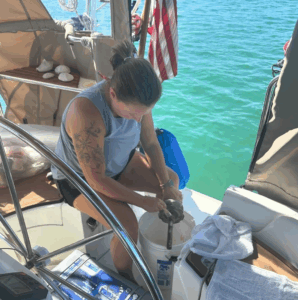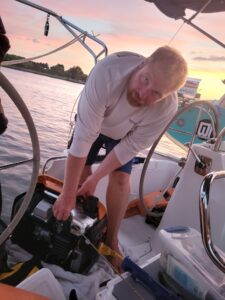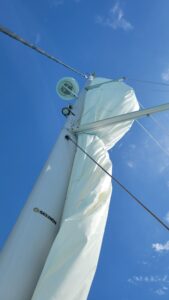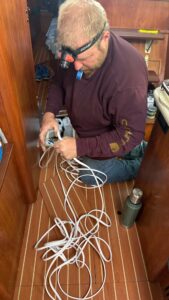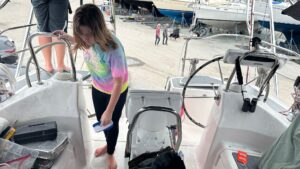About the Swiacke Family
We are Tony, Anna, Sophia and Bolt. We have been sailing the east coast of the USA and the Bahamas for the past 2 cruising seasons and have plans to continue further south into the Caribbean. We are electricians, digital creators, and students. Follow our track at www.noforeignland.com/boat/svbogumila or our posts on Instagram instagram.com/svbogumila or drop us a message at svbogumila@gmail.com. We hope to see you out there.
Passages South (Long Island Sound and New York Harbor)New London, CT to New York, NYOur cruising plans started one winter day 8 months before our departure. We wanted to escape the cold winter of Connecticut, show our daughter that there is more to life than the hustle and bustle of New England living and work created an atmosphere for the previous 10 years that required a break; even for the most strong willed. The plan was to sail for just for a year, head to the Bahamas for a season and come back to some sort of land based life after we returned; little did we know at the time 2 years later we are making plans to stay as long as we were happy doing it.
We left our home port just north of long island sound in mid September of 2023 on a foggy morning bound west to New York, NY. As we called back to the bridge “thanks for the opening and see ya next year” there was a moment of joy, bittersweetness and anxiety of the unknown. We had done weekends aboard, week long trips and a delivery of our boat from Vermont to Connecticut but this was different. Our daughter Sophia was excited as ever, its funny how kids adapt to new things so easily and this new lifestyle was no different. We made our way past ledge light and out of the mouth of the Thames River; shortly after turning west down long island sound an hour or so into our sail a strong front coming from the northwest came right over the top of us. We watched another sailboat fly past us in the same direction, heave to, wait for the front to pass and then continued on about their journey. I still admire that boat and it think of that moment to this day, so confident the captain as they precisely executed their maneuvered then continued on their journey like nothing ever happened. We took a much different approach of beating into the weather like we were driving a car as rain drove sideways into the cockpit. With the girls downstairs everyone listened to the thunder rumble through the sound as the boat steered under autopilot toward Branford, CT.
Our first stop of the trip would be Thimble Islands which is a small group of islands on the Northern side of the sound named this way because the islands look like small thimbles sticking out of the water. Its beautiful and can remind you of the Maine coastline. We “dropped” the anchor based on the conditions, lowered the dinghy and headed to town to walk the dog. After a brief walk, a failed attempt to get an ice cream and a dinghy ride back to the boat we settled in for the night. Sophia fished off the forward deck and we sat and enjoyed the view of the sunset and waited for nightfall. Over the years we have used a couple different options for anchor alarms and I have learned a lot from past mistakes made in setting them right now we use anchor pro which seems to work the best of us we set it and now keep the app open on a phone upside-down so the light doesn’t affect us sleeping in our cabin this way it actually alarms when there is a potential issue. As the sun set we turned in for the night, suddenly at 3 A.M. we were startled out of bed. We arose to find the boat dragging in 20-25 knots with the wind coming from the opposite direction than where is was when we turned in, clearly I didn’t recognize the change at this stage in our cruising life. Of course we immediately started the engine with Anna at the helm we safely motored forward and out of the danger of the rocks. A total of a 1/4 mile we dragged from our initial position into the channel and on our way out into the sound. We narrowly escaped rocks, avoided the lobster pots and even missed a moored boat by feet as we frantically worked on raising the anchor and getting the boat back to safety. As I do during the events that create havoc I thought about what could we have possibly done wrong, we skipped a step that our instructor taught us long ago on a previous boat, to back down at a minimum of 2000 RPM. Why? Who knows maybe it was the first night jitters, extra confidence from actually slipping the lines and leaving or maybe it was lack of thought of what needed to be done I think eventually it happens to everyone. Either way the dream could have ended on the first night out but Bogumila had other plans and was looking out for her crew in more ways than one. In the remaining darkness of the night I sat in the cockpit after resetting the anchor and watched the water boil as the sunrise brought in schools of striped bass and bluefish. A quick walk with the dog on shore, breakfast to refuel for the day and a brush off of our egos we picked up the anchor and put an end to our first anchorage with a few new lessons learned.
As we left the Thimble Islands another sailing family who also departed New London, CT passed by us in route to the Bahamas as well. We said quick hello and later created many memories together. They turned in to harbor just after passing by New Haven but we had plans of making it to Norwalk, CT to find a place to hide while Hurricane Lee passed by us. The forecast wasn’t clear at the time for what the storm was going to do but we picked Norwalk because of its all around protection from the sound and availability of moorings and marinas. Having made no reservations prior to our arrival we called a few places and quickly realized that there wasn’t much available unless we went way up the river fortunately we lucked out and found the municipal mooring field, checked in and secured the boat for the night. After the previous nights adventures we were happy to be secured to something we were more familiar with and knew wouldn’t move while we slept. Norwalk is a fairly nice town but its more closely related to a NYC’s suburb than a quaint Connecticut town you think of when you see a Yankee Magazine but it had enough to keep us busy while we were there. We happily visited the Norwalk Aquarium, the local mall, local grocers and a few restaurants during our 4 day stay. There is reasonable access to the boat ramp to walk the dog if you have one and I can recommend the moorings if they are available when your in town but the marinas are expensive given their location.
After hurricane Lee passed by to the east making more of a presence on the eastern New England shoreline than in Norwalk it was finally time to leave. A quick stop for fuel and of course I dropped the fuel cap into the water and had to replace it in the local ships store, add a rationing chain to the list of things to do. We were on our way to Port Washington, NY on the south long island sound shoreline.Port Washington, NY for those of you who may have not visited yet is probably one of the most convenient stops in all of the eastern seaboard from our experience. Things that we consider convenient to cruisers are ease of access to land, access to necessities like grocery stores, chandleries and basic needs and access to local attractions for things to keep our the crew occupied. There is 2 public dinghy docks along with several marinas and yacht clubs as well as a public park within the anchorage, the grocery store is across the street from the North dinghy dock and is no more than a few hundred foot walk, the west marine is a 1/4 mile north from the dock location, serval very good restaurants exist within walking distance. One of the best parts of this anchorage is that there is access to the LIIR railroad station no more than a mile away from the dinghy dock. This train goes directly into NYC’s Penn station and takes about 45 minutes to get there. This gives you access to the entire city VIA public transportation at a fraction of the price of staying in Brooklyn or on the NJ side of the Hudson River. If you have never been to NYC and you enjoy visiting cities you have a plethora of options to see and do from this harbor.
The second best part about port Washington is for the weary sailor. Those that find there way here northbound and you are lucky enough to catch and open mooring you have access to the town VIA water taxi as of 2025 the moorings are no longer free on the first night which was one of the best deals around but at $35/ngt with launch service there is nothing better than resting on a mooring after a long sail. Points south are a long stretch here from Cape May/ Lewes, the Delaware Bay, Norfolk or points south its a welcoming sight to tie up to a mooring to get some good needed rest. Southbound yachts can stop here to make the best timing of the East River and the infamous Hells Gate. You can certainly not go wrong with stopping here in either direction.
After a few days in Port Washington it was time to leave. From here transiting the east river is an breeze from the harbor its maybe 2 hours or so to the gate which makes timing this run very easy. We had done hells gate a couple times in the past and there is a plethora of information online, in pilot guides and other resources to plan your trip in either direction. Its a great experience to see NYC from the water and a very exciting day that ends with a view of the statue of liberty going westbound. There is something that the world is enamored by with this landmark; it has beauty like no other and stands for something almost everyone can relate to. Every time we pass by here there is always several photo ops and no matter how many photos you have of lady liberty there’s just one more you can take. After our sail by we typically stop at the city marina just north of Ellis island on the Hudson River to top up with fuel for the next leg down the NJ shoreline. We quickly topped up our tank and headed to Atlantic highlands for a rest before the long stretch south along the NJ shore.
BreakdownsBy Anthony SwiackeIn our two cruising seasons along the Eastern U.S. and the Bahamas, we’ve experienced our fair share of breakdowns and equipment failures aboard the boat. Most of these issues are repairable with a little ingenuity and pre-planning. Others, seemingly unavoidable, are often costly—but as the common cruiser saying goes, “It’s a boat.” That’s why we always budget for repairs as part of our cruising plans.During our first season in the Bahamas, our major catastrophe was a failed windlass. The failure stemmed from years of neglect and poor engineering on the manufacturer’s part. In hindsight, we hand-hauled the anchor for five weeks and reflected on how we ended up in that situation. Did we simply overlook servicing the windlass? It was a sealed unit and appeared to be working perfectly when we left the U.S. It lasted almost three months before seizing due to saltwater intrusion through the bearing seal.The key takeaway was that the windlass could have failed at any time—and that it would have been much easier (and cheaper) to carry a spare rebuild kit than to try sourcing one while in foreign waters. After eventually finding a kit in Ireland, shipping it to the U.S., and dealing with the nightmare of freight forwarding to the remote islands of the Bahamas (a process that took over six weeks!), it became clear: always carry a spare when you can.Which brings me to: Spares… Spares… Spares.When I first started planning our cruising adventures, I took inventory of what I believed were critical components. These were mostly the low-hanging fruit:If the dinghy engine quits, what’s the likely culprit? (Carburetor, spark, fuel filter, etc.)If the auxiliary engine dies, what might be to blame? (Fuel filters, low oil, bad injector?)These types of issues are usually easy to spot. Doing regular maintenance and pre-departure checks helps you get to know your systems—and catch small problems before they become big ones. No one wants to be stranded, even if there’s often a helpful fellow cruiser nearby.But what if the electric flush toilet macerator fails? What will you do with a bowl of your own waste? And after you figure out how to get rid of it, how will you flush the toilet again?What if the overboard macerator pump fails—and you’re in a remote location with no pump-outs?What if your freshwater pump breaks? How will you access drinking water?What if you rip a sail? How will you keep moving forward to reach the next port?There are countless things to consider. Some are obvious; others require more critical analysis. One thing is certain: the more complex your boat, the more important it is to review every system and identify potential failure points.A good example is from our recent trip north. One morning before departure, we discovered our fixed VHF was blowing fuses. After troubleshooting—and confirming with the manufacturer—we learned it had developed an internal short. Three blown fuses later, we switched to our handheld VHF and continued on. That handheld also supports AA batteries in case the main battery or charging base fails (both of which have happened to us in the past). In this case, we had a primary system and two backup options.Here’s a list of systems we consider critical to daily life aboard:Freshwater systems – including pumps, watermaker filters, and an assortment of common fittingsMacerator pumps – motors, rebuild kits, and toilet accessoriesGround tackle systems – rebuild kits, controllers, buttons, and relays related to anchor handlingRefrigeration – fridge/freezer control boards, refrigerant, and a gauge set for topping offElectrical components – breakers, shore power relays, system-specific fuses, and spare lampsVHF systems – antenna, cable connectors, and a handheld VHFNavigation – paper charts and tools (essential if your plotter is taken out by a stray current or lightning strike; iPads and OpenCPN are great, but only if you still have power)Sail repair – sail tape, small sheets of Dacron, and a sewing kitDinghy engine spares – a full replacement carburetor (if you’re not mechanically inclined), rebuild kits, fuel filters, spark plugs, pull cords, and electric start relaysUltimately, consider your own boat’s systems and which ones are essential to your comfort, safety, and mobility. You are your own floating municipality—and usually, only you are responsible for keeping your vessel in shipshape condition.”Anna cleaning our old windlass shaft in marsh harbor for reinstallation.
Tony trying to repair our trusty portable generac generator, needless to say there was no saving it.
The worst: a jammed, ripped mainsail and a broken stay found in Cat Island Bahamas.Boat Kid’s PerspectiveBy Sophia Swiacke
Hello friends! My name is Sophia. I’m 10 years old and I’m a boat kid.For as long as I can remember my parents have been taking me sailing.
I started when I was 3.5 years old I think? Back then we had a a little sailboat we
took out on a lakes for a day trips. As I got older our boats got bigger 😁 and my
parents sign me up for summer sailing classes. I’ve had such a good time meeting kids from all over the state sailing Opti dinghies and hanging out on a beach. I’ve been sailing on my own Opti when I was about 6-7 years old in New London Yacht Club. We then bought a bigger sailboat and sailed around the Long Island Sound for couple of years .But deep down as a family we had a bigger dream to travel farther into the beautiful blue waters of Bahamas 🇧🇸. There is no better feeling then going there and see that blue water for a first time. Back than we begin search for a cruising worth boat.About few months later we found our dream boat in Vermont which meant we had to bring it back home and get it ready for our big journey. it took us two weeks to bring it back down the Champlain canal down the Hudson River into NYC and back to New London CT. That was a great trip and we really enjoyed staying in different places along the way, and seeing Statue of Liberty from a water was just incredible experience.After that we begin refitting our new boat and getting her ready for our big journey. Fallowing year in September we packed everything we needed and said our goodbyes to our family and friends as our journey
were to begin. At that time I was 9.5 years old I left my school, friends ,dance studio and everything that was familiar to me for so long .We were officially living aboard our sailboat.I had my own bedroom I decorated to make it feel like my room at home. Our family felt closer together then ever before. We sailed the East Coast of USA visiting many incredible places I’ve only ever heard about.We took our time exploring and learning about there history and culture. We’ve met a lot of nice people along the way. Many boat kids from all over the world.As being on a sailboat full time I’m homeschooled which is so great because school only takes me 2-3hours a day and then I have freedom to explore, pick a new place to visit with my mom and dad. I love being able to spend so much time with them and also have time to do other things love. On a boat I have my keyboard I like to learn to play new music, I also love to draw lately a lot of animation things. I love to read and spend time with my dog Bolt. I still keep in touch with some of my friends from home but to be honest sometimes it feels like some people don’t understand what we do and we are doing this!? And it’s ok. One of my favorite things about sailing is going swimming and snorkeling just watching all the beautiful fish and ocean creatures. I like fishing with my dad and doing for all kinds of interesting things . I like cooking in a galley with my mom and go helping with some boat chores. Yes on a boat there is still chores to do ,we like to keep our boat clean. Its kind of important since we are all in a small space together. We spend little over months in Bahamas last year and made a lot of friends. We had a blast sailing from the island to island and hanging on a beach and swimming lots of swimming. When our time there came to end we had a huge sense of accomplishment our big dream of sailing there came true. We made a lot of unforgettable memories and I will forever cherish them. Going back home felt like our journey wasn’t over yet like we supposed to keep going. We visited Washington DC spend over two weeks there visiting every museum I dreamed to see.it was a wonderful experience to be able to anchor a boat in a middle of a city. I think that’s supposedly other thing I love about sailing time feels like it’s slowing down we are never in a rush unless there is bad weather and we had to find safe place to stay. Most kids my age don’t get a chance to travel like this or to do what we do. I’m no different then other kids I love to play games meet new friends and just be silly. But most of all I’m very grateful for my parents for giving me this gift of adventure. Letting me see the world with my own eyes and not just reading about it. I’m only 10 years old and I’ve seen a lot of the world and had some great experiences. If you ask if I miss my family and friend the answer will always be yes! But they are just a phone call , video call away .They are always welcome to visit us wherever we are. Guess what ? This year we are on another adventure we fell in love with this lifestyle. We also got a bigger boat lol…honestly we are not really sure where we might go so far we are heading south ☀️ we are meeting back with our boat friends and we are happy to be together. Family is everything and as long as we are all together our boat is our home. We hope to see the world where ever our boat can take us. The adventure continues…Bye 👋 talk soon!Boat girl Sophia
Managing it, on the hard
Our take on making the best of being hauled out…
Our conversation about the next haul out of Bogumila II started as soon as we bought her. Our situation was different than some; during a whim Google search while stuck in a blow on our Hunter 376, she stuck out like a sore thumb, neglected on a dock in Ft. Lauderdale just waiting for her next owner. Soon came the initial look, then the survey, which found her sound. After finalizing a drawn-out deal for a couple of months, we took ownership and took her back to New England, had a lightning strike, and had her hauled 2 more times, which revealed some other required maintenance. We determined getting hauled out to get these much-needed delayed maintenance items done was a priority.
All boats, even new ones, need maintenance and upgrades to keep them in good working order. It’s almost impossible to remember everything, and from the get-go we kept track of even the most minute details.
Bottom job.
Though hull for our watermaker.
Replace the zincs on our prop and bow thruster..
Repair the keel damage that revealed its ugly head after the survey..
Remediate the small delamination and rust on the keel…
Wax the hull…And on and on…
We keep a running list of things of all sizes: small drip from a hatch seal, chip in our gelcoat, squeaking block—all of it goes on the list. It lays out everything and allows us to keep a record of what we did when too. But most importantly, it allows us to prioritize items visually. The most immediate item for us was to get the bottom stripped and repainted. We feel this is always a big step to the longevity of the boat, avoiding blisters, keeping her fast on the water, and keeping some of the critters at bay.
The first step for us was to find a yard suitable for the work. For us it needed to be DIY, liveaboard, with a way to get packages, groceries, etc. When we look for boatyards, we look at affordability, the climate of the location, and if we can stay on the boat while we do the work. Doing bottom work in Florida in December is much more comfortable than doing bottom work in Grenada in July. With the boxes checked, we honed in on Green Cove Springs Marina in Florida and took her back south. We scheduled our haul out well in advance, about 3 months, and we shuffled the date as weather and timing factors played out. Most marinas are very flexible with these dates because they understand there are many variables that play a factor. So we kept in touch and updated them on our plans as things got closer.
Contractors… ugh, contractors. We have always heard horror stories about folks hauled out in the midst of their work and the contractor disappears. Eventually, it’s always sorted in some way, but it’s unneeded stress put upon yourself. Once you determine where you are hauling out, you should contact the yard to get their recommendations for contractors to do the work. Most yards tack on a percentage to the contractor’s invoice of the work done, so do your homework and find one that doesn’t. We will say that we exclusively do almost all of our own work, but in the instance of the bottom sanding, which we had done before on our beloved Tartan 28, we wanted help. It’s a dirty job that I wouldn’t wish on my worst enemy.
After making some calls and checking their references, secure the work and make sure that they know you’re serious. Ask them if deposits or payments are needed and how they want to be paid at the completion of work. Ask them how they plan to do the work; simple details are fine, but it will explain the difference between sanding for 10 weeks with an 80-grit orbital or if they will grind off the paint with efficiency. Once the details are sorted, it’s important to follow up early and often with the contractor to ensure that they know what and when. Tell them when you’re going to be there so they can schedule their manpower, order supplies/materials, and set a timeline for the work; make sure it’s clear where you’re hauling and follow up several times as you get closer to remind them about the job you want done if they don’t answer or return your calls its probably a red flag.
Doing the work: After you laid out a list of what you’re doing, next is how. For bottom painting, it’s pretty straightforward: grind, sand, fair, prep, and paint. If you’re doing the work, put together (yes, another list) of things you need and add 10% to each. Paint calls for 2 gallons; order 2 gallons and a quart to make sure you have enough, and in the worst case, you roll more paint on and use up what you have. For 550 sq ft of sanding, we went through at least (30) 35-grit 5″ disks. At a minimum, ordering enough plus some will save hours or days to your project, which equates to money and, most importantly, time on the water. For things like electrical or plumbing upgrades, draw out schematics; after initial investigation on what’s existing, add in what you’re planning on doing and make sure your installation is to the latest practices and standards before you start. Missing just 1 fitting or cable connector can result in another trip to the chandler. Making sure you have that material there to do the work by far can turn a 2-month nightmare into a 2-3 week haul.
Execute; boat projects are time-consuming, and usually gremlins rear their ugly head once you get started. If you find yourself hauled with a failed rudder bearing, ask for help. Almost all of the boaters in the yard will lend a hand or knowledge of how to fix something. Sometimes you will have a delay; that’s just part of it work quickly to find a resolution. After we hauled we found our old bearing had too much play so we asked around for a machinist to get another made. They were happy to stop by and take the measurements for a new one. Within a couple of days the replacement showed up and we were well on our way.
Going back in. After the majority of the work has been done and the dust has settled. Take stock of what you have done; we keep an electronic record of everything that we did, the part number, model, and mfg cut sheet go into a file on our Google Drive for future reference. We have needed it for ourselves or others many times, and in today’s electronic age, it’s easy to declutter the paper by scanning it in. Go over each thing that you have done to ensure that everything is in ship shape before she goes in the water. Check all through-hulls, check your electronics and nav systems, make sure your rudder spins freely, make sure your engine starts, check auxiliary components, and add zincs where you need them.
With your yard work done and your boat back in the water, you can now enjoy the fruits of your labor. Hopefully you’re heading off to exotic locations, but if not, you will rest easy knowing that things are well below the waterline.








